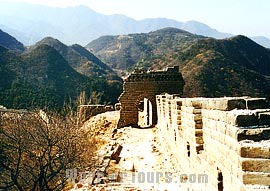Great Wall of China

The majestic Great Wall of China is the greatest ancient military fortification in the world and has been listed in the World Heritage by UNESCO since 1987. Starting from Shanhaiguan Pass in Liaoning Province to Jiayuguan Pass in Gansu Province, Great Wall winds through the mountain and desert areas of northern China from east to west.
It is recorded that construction of the wall began in the Spring and Autumn Period (770 BC - 476 BC) in China's history. By defeating other six warring states, Emperor Qin Shi Huang unified the country and built up the first dynasty in China's feudal society, the Qin (221 BC - 206 BC). To consolidate the defense of the northern border, the emperor sent, Meng Tian, a famous Qin general to connect the incomplete wall structures of the previous six states and build a continuous wall construction.

The ancient Qin wall has experienced continuous extensions and restorations throughout the 2,000-year history of Chinese feudal society. Two construction campaigns in the Han (206 BC - 220) and Ming (1368 - 1644) dynasties brought about the remarkable extensions to the wall. The present wall remains in Beijing are mainly the result of the Ming period.
The wall sections in Beijing include Badaling, Jinshanling, Mutianyu, Simatai, Huanghuacheng, Jiankou and others. Among them the best-preserved Badaling Great Wall is the most popular choice for tourists. In China, there is a saying that the man who has not been to the wall is not a real man. The Great Wall is the symbol of China, the spirit of the nation and an object of pride for the Chinese people. (See also Great Wall Weather.)
![]() Jinshanling Great Wall
Jinshanling Great Wall
At the northeastern edge of Beijing, there is a wall range winding from east to west as the prelude of the Great Wall in Beijing area. This range is composed of three sections from east to west, namely Simatai, Jinshanling and Gubeikou. Jinshanling Great Wall refers to the middle.

Located in Luanping County, some 130 kilometers (81 miles) away from the city area of Bejing, Jinshanling Great Wall is second only to the Badaling Great Wall in its completeness. This section was named because it was built on the Bigger and Smaller Jinshan Mountains. It is divided into two parts: Jinshanling part and Wang Jing Lou part. Jinshanling part is nearly seven kilometers (4.4 miles) long and joins Simatai in the east. Wang Jing Lou (Watching Beijing Tower) is the highest point in this section with a steep flight of steps ascending up to nearly 900 meters (nearly 3,000 feet) above sea level and from the top, one is said to see Beijing, hence the name.
Compared to other sections in Beijing, the section was built in the late period of Ming Dynasty (1368 - 1644) and the designers improved on the previous constructions in other sections and added a full range of more sophisticated defense fortifications to this section. For example, barrier walls are rows of embrasured walls built vertically to the main body of the wall, which prevented enemy who had arrived at the top of the wall from further attacking. Guarding soldiers could be sheltered from the frontal attacks by squatting behind these walls. Three lines of bell-mounted shooting holes built in crenellated battlements enable three rows of archers shooting at the same time. The horse-block walls were constructed onto ramps within the pass, which denied access for both enemy horses and men to the top of the wall. All these designs have enhanced the overall defensive capability of this fortification.
| Admission Fee | CNY 65 (Mar.16 to Nov.15); CNY 55 (Nov.16 to Mar.15) |
| Cable Car: CNY 40 per person for a single-trip | |
| Opening Hours | 08:00 to 16:50 |
| Recommended Time for a Visit | Two hours |
| Transportation |
A. Take bus No. 980 from Dongzhimen to Miyun Bus Station, and a local bus, taxi or mini bus to Jinshanling Great Wall; |

